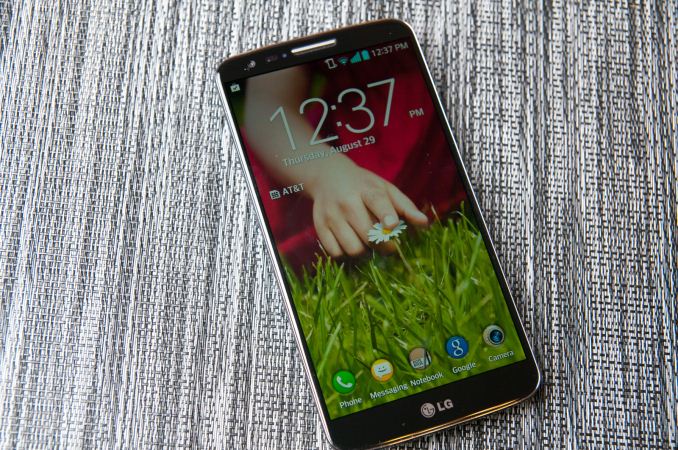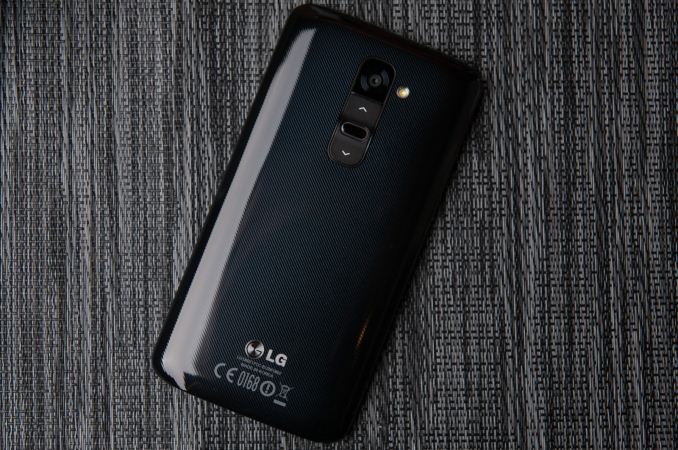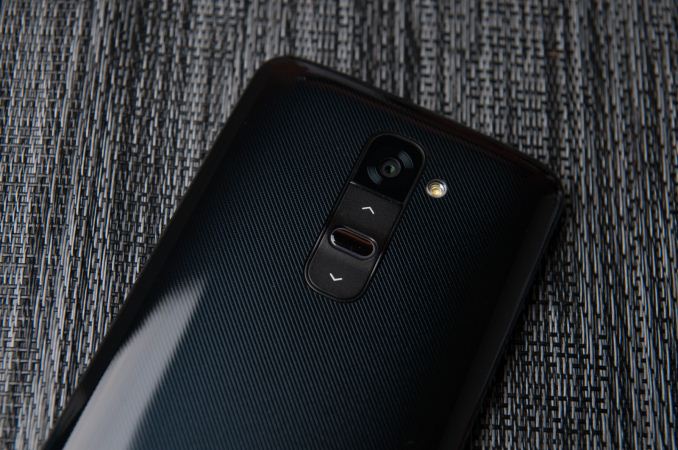LG G2 and MSM8974 Snapdragon 800 - Mini Review
by Brian Klug on September 7, 2013 1:11 AM EST- Posted in
- Smartphones
- LG
- Mobile
- LG G2
- Android 4.2
- MSM8974
- Snapdragon 800

The LG G2 is the spiritual successor to the Optimus G, a device that we looked at last year and eventually went on to become the Nexus 4. LG dropped the "Optimus" branding this time, but the G2 is without a doubt still LG's flagship smartphone, and includes a number of unique LG features – stacked 3000 mAh (11.4 Whr) battery with SiO+ anode, 5.2-inch 1080p LCD from LG Display, and 13 MP rear facing camera with OIS (Optical Image Stabilization). It's an impressive combination of features that make the G2 a standout device. At the same time the G2 is our first chance to get a look at the 2.3 GHz bin of Snapdragon 800 inside a shipping device and get a look at performance and battery life.
We took a quick look at the G2 at the announcement event, now we have our hands on a G2 and have been putting it through its paces, benchmarking it, and running battery life tests on it for a little under a week and wanted to share some thoughts.
Hardware Impressions
The G2 marries a curved backside shape with front glass that slightly curves at the edges and has a very narrow side bezel. The G2 also opts for on-screen buttons rather than the discrete capacitive kind or physical buttons that went out of favor a while ago. The reality is that Google does have a fair amount of input into at least this part of the Android ecosystem, and its guidance seems to be that on-screen buttons which use display real estate to draw the buttons is the recommended way to go. The G2 does afford the ability however to add Quick Memo buttons or the notification shade pull down/pull up buttons to the bar, but oddly enough there's no multitasking button option available.
The G2 manages to include a large display without width that's much different from other devices I've been using lately, like the HTC One. Part of getting the edge bezel small was a reduction in volume required on the sides for volume and power buttons, which are instead moved to the back of the G2, perhaps its most striking and initially even alarming design change.
Holding down the volume down button launches you into the camera, pressing the center button powers on the phone, and holding down the top button launches QuickMemo. Up and down are volume up and down otherwise. There's a hard raised lip on both sides of the button too, so the G2 when laid backside down on a surface makes contact there instead of on the button – it won't inadverntely turn on when pressed against a table. I found the backside buttons easy to adapt to after my first few interactions with the G2, and they actually become second nature after a day or so. The raised bump for the power button makes it easy to locate with the index finger, and I haven't smeared or accidentally put my finger on the sapphire camera cover yet. If the power button on the back is still difficult to get used to, the G2 has a double tap to turn on feature it calls "knock knock" – double tap on the display, and the G2 will turn on, repeat the double tap on the status bar or in an empty part of the display when it's on, and it turns off. I find myself using the double tap gesture quite a bit to turn the G2 on and off. I believe this functionality uses the sensors onboard and the DSP inside 8974 to detect when the taps occur.
The G2 I was sampled is a dark blue color which has a slight pinstripe on the back as shown in the photos above. The material is however the same kind of glossy plastic I'm used to seeing out of the Korean handset makers of note, and picks up fingerprints and hand oil very quickly unfortunately. I like the shape of the device and LG's innovations, it's just puzzling to me that materials hasn't picked up yet, I'd even take glass from the Optimus G over plastic. I'll save you the huge discussion on device size as well, I'm fine with the larger smartphones that aren't quite phablets, and the G2 for me is totally usable and I appreciate the increased display size. It definitely isn't phablet size, but it is on the larger high-end smartphone side of things.
| LG G2 | |
| SoC |
Qualcomm Snapdragon 800 (MSM8974) 4x Krait 400 2.3 GHz, Adreno 330 GPU |
| Display | 5.2-inch IPS-LCD 1920x1080 Full HD |
| RAM | 2GB LPDDR3 800 MHz |
| WiFi | 802.11a/b/g/n/ac, BT 4.0 |
| Storage | 32 GB internal |
| I/O | microUSB 2.0, 3.5mm headphone, NFC, Miracast, IR |
| OS | Android 4.2.2 |
| Battery | 3000 mAh (11.4 Whr) 3.8V stacked battery |
| Size / Mass | 138.5 x 70.9 x 9.14 mm |
| Camera |
13 MP with OIS and Flash (Rear Facing) 2.1 MP Full HD (Front Facing) |



















120 Comments
View All Comments
et20 - Saturday, September 7, 2013 - link
No, they are not too stupid.You are too stupid to understand that not everyone cares about the same things as you do.
The simple fact that you are reading and commenting on this site is clear indication you are part of a tiny minority.
You are completely disconnected from the needs and interests of mass market consumers.
The sales guy you mentioned is paid by Samsung to sell more Samsung phones. Almost nobody uses SD cards.
theduckofdeath - Sunday, September 8, 2013 - link
Almost no one uses SD cards? Do you have any fact to base that statement on?SD cards are not the primary reason people prefer Samsung phones, but they are definitely one of the contributing arguments when people buy phones. Clearly, vanity is not as highly rated in real life as HTC thought. People apparently prefers to spend their money of useful things, not just looks.
UpSpin - Saturday, September 7, 2013 - link
Now you come with rooting. I'm a science student and technically interested (as it's obvious because I'm here on this site). I've rooted my smartphone and will do the same to all my future smartphones. It's a no brainer for me. A lot of my friends own an Android smartphone, too. They are in no way stupid. But none of them has a rooted device. I don't know a single one in my surrounding who rooted it. To some I explained them the beneifts, how to do it, etc. But none did it. Why? Because they had no urgent need for it and didn't want to 'waste' time doing it.Some of the smartphones they use have a SD-Card, none of them really cared. None of them heavily uses it.
I'm sorry to burst your ignorant selfish bubble, but not everyone is like you and wants the same you do!
Samsung has the highest marketing expense of possible any company on earth. People who go in a store and want to buy a smartphone, know mostly nothing about the different flavors of smartphones, but they do know, that Samsung has some, lots of them, with nice looking features, according to the ads they see in TV/web/posters just everywhere! The sales person also probably knows the advantages of Samsung devices best, so it's no surprise that most people just buy a Samsung smartphone. The fine differences between the different smartphones are negligible for most people and few even understand them or value them.
Few know what OS they are running on, let alone the precise Android version.
The majority chose a smartphone by:
1. Price
2. Look, feel, size
3. Devices they saw from ads
4. Recommendation from friends
You aren't the smartest either, if you think that the only outstanding feature of the HTC One is the dual speakers. There's the aluminum body, OIS, magnitudes brighter display, software features and others left, which you don't care about and thus don't care about.
BabelHuber - Saturday, September 7, 2013 - link
You are calling me stupid while you are to dense to recognize two major points I made besides rooting:1.) People use SD-cards to store music at. I know lots of people who use their SD-cards exclusively this way without having rooted their phones.
Only an imbecile can say that it is no advantage that you can put an SD-card into your notebook, copy all movies and music you want to it, put it into your phone and use it.
You do not need much technical knowledge to do so, and in fact lots of people do exactly this. Ask them if this feature is worthless!
2.) You do not seem to understand the gap regarding sales between Samsung and any other Android phone manufacturer.
Samsung sold about 70 Million smartphones in Q2 2013, while LG, Sony, HTC, Huawei and ZTE can be glad to sell one tenth of this number!
And you say the fact that SD-card support and a removable battery play no role at all? And then you call me stupid?
Let me give you a clue: If only 5% of Samsung customers care about SD-cards, this is 3.5 Million customers per quarter. If 10% care about this, it is 7 Millions.
And you are telling me that this is a non-issue for companies which sell 5-7 Million smartphones per quarter? That they do not want or need these customers?
I really do not understand what is so hard to understand here!
maximumGPU - Saturday, September 7, 2013 - link
Are you really saying that you single-handedly just uncovered the reason for HTC, LG, Sony and all the rest's low market share?And here they were scratching their hair completely baffled at just why Samsung handsets were selling so much. Everyone in there market research team should be fired for failing to see that simply adding an SD card slot would immediately result in at least 3.5 million extra sales per quarter.
BabelHuber - Saturday, September 7, 2013 - link
No. I am saying that this is one reason - in the sense that this lacking features makes it harder for them to compete.And yes, I think their management is stupid.
blacks329 - Saturday, September 7, 2013 - link
You honestly think 1 in 20 people care about SD cards in their phones? I suggest you do a poll of the layman and find out how many of them actually care.Apple sells 40 million iPhones a quarter, I wonder how they can sell so many?
/psssssst it's not SD cards
BabelHuber - Monday, September 9, 2013 - link
When a company wants to compete against Apple, it makes sense to look at the strengths and weaknesses of the competitor.Apple does not have removable batteries and SD-card slots.
So it is a cheap win to offer these features for those customers who do care. OTOH competing with Apple without having such obvious advantages is tougher.
deskjob - Saturday, September 7, 2013 - link
Hey bud, I agree with you - the SD card expansion is a valuable feature to have. If I was given the choice to have it or not, with absolutely no trade-off, then duh of course I'll want to have the feature.But I want to share my personal experience so far - my smartphone history up to this point is the HTC Thunderbolt, Rezound and now the One. I loved having the SD card expansion. I rooted and S-off'ed both the Thunderbolt and Rezound (shorting out two contacts on my brand new Rezound in order to get S-off was a damn crazy leap of faith). And I always thought that I wouldn't get a phone without SD card expansion, ever. Period.
But then when I actually looked at my usage pattern - after the initial transfer from the Thunderbolt to Rezound, I never once took out the microSD card again for data transfer. Hell, I actually bought a 64GB card for the Rezound (I jacked the 32GB from the Thunderbolt originally), because the phone actually supported it unofficially (the card capacity didn't exist when the phone was first out!). But you know what... the 64GB card never made it into the phone. It's now in my Nikon SLR.
And dude trust me, I put that extra storage space to good use. Talking about multiple NAND backups, my music library, a movie or two, photos, Titanium app backups, the works. But that's just it - what I need, and I suspect most people need, isn't the microSD expansion per se. We need SPACE! As long as there's enough space to fit your need, who cares if it's microSD, internal, or even cloud? Okay, cloud might be iffy with security and extra power draw from data connection, not to mention data cap (not for me though, unlimited data hehe). Look at it from another perspective - if your phone came with 128GB of internal space, would you be able to do without microSD expansion?
And as you might know, the way Android handles external SD space isn't very elegant. You have to keep track of the system partition, the internal SD, and the external SD. It sounds trivial, but it's not elegant and gets more annoying as you go forward. At least for me. I honestly can't see the majority of the public dealing with this and feeling happy about it.
Marketing is everything, unfortunately. I think we've reached a point in the smartphone market where most phones are ADEQUATE. They'll do the job of calls, internet, chat, camera, etc. Marketing is the key to making people want to buy your product. Samsung is great at it. Apple is great at it. HTC and the rest, not so much.
Did you know that Samsung went as far as to hire poor college and grad students to post negative comments about competitor phones on major tech review forums and sites? Look it up - they admitted to it, and blamed it on some "rogue individuals" within the company. No... they were sorry they got caught.
nerd1 - Saturday, September 7, 2013 - link
Yes expandable storage is so old school - apple will soon make macbooks with soldered on SSDs, cameras with only internal memory, and so on. In fact they are already doing that (rMBP's RAM is soldered and SSD is proprietary format)